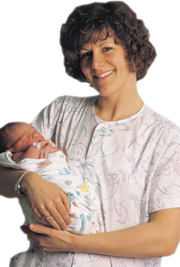Who is available to deliver babies, and where do they work?

Homebirths and family birth centres are usually run by midwives. Midwives tend to facilitate uncomplicated births independently in hospitals. Students are often present and may assist. Obstetric registrars (training specialists) often become involved if assisted deliveries (forceps, vacuum delivery) are required, or if there are issues with the health of the mother or her baby. Consultant obstetricians (specialists in charge) facilitate more complex or high risk deliveries. In the private sector, consultant obstetricians facilitate birth regardless, while midwives assist throughout the labour itself.
Doctor
In Australia, doctors who specialise in delivering babies and caring for pregnant women are known as obstetricians. Obstetricians usually also train in gynaecology, which is a specialty dealing with the health of the female reproductive system (ovaries, uterus, cervix, vagina). Obstetricians may practice in both Obstetrics and Gynaecology, or they may only deal with Obstetrics. Some GPs do extra training in obstetrics (in addition to their GP specialty training), and are known as GP Obstetricians.
Uncomplicated, routine births do not generally require the presence of a doctor in addition to a well trained midwife. Doctors tend to anticipate and manage any complications that may arise during delivery. They are trained to carry out procedures (such as caesarean section) that may be necessary to save the life of a mother or infant if something goes wrong during delivery. During pregnancy, if it becomes obvious that a birth is going to be difficult or risky for the mother or baby, it is usually advised that a women goes through labour in a setting where a doctor is close by if needed (such as at hospital, rather than at home). This would be the case for women with very large or small babies, breech babies, women with high blood pressure, women with certain medical conditions, women who have problems with the function or position of their placenta, and women who have had previous caesarean sections.
If women choose to have a particular doctor present at their birth, they may have to organise this privately (i.e. through private health insurance). In public hospitals, women are not generally able to choose which obstetrician will assist in their delivery. Often a training obstetrician (obstetric registrar) will assist in the delivery, and a consultant obstetrician (who has completed their training) will only become involved in more complex cases. Some women may prefer their GP to deliver their baby. If your GP has trained as a GP obstetrician, it may be possible for them to deliver your baby if they are available, and if they feel confident that the delivery will be not too complicated.
Advantages: Doctors are capable of dealing with both high and low risk pregnancies, and are able to administer a wider option of pain relief during labour if it is requested by the patient. They are also more likely to be better equipped to handle emergencies if they do arise, and have the authority to perform emergency procedures that may not be able to be performed by a midwife.
Disadvantages: Doctors tend to spend far less time with women in labour than midwives. They will check on the woman at intervals, then become more involved once the baby is actually ready to come out. As a result, they tend not to form the same level of relationship with the woman giving birth. Many doctors focus on the ‘medical’ aspects of the health of the mother and baby, and the procedures involved, rather than focusing on the woman and her experience of the labour. It is important to note that the level of personal attention a woman receives will vary between individual doctors.
Midwife

Advantages: Midwives generally provide a lot of personal attention during labour and childbirth, staying with the woman throughout the entire process. As a result, they usually build up a personal relationship with the patient, establishing a sense of trust which may put women at ease. They are also more likely to assist and encourage complementary forms of pain relief and relaxation, such as warm showers, hypnotherapy etc.
Midwives receive years of training, specialising in the management of pregnant women. They are extremely knowledgeable, and are able to recognise when problems arise which need to be managed in a different setting or by a doctor. Midwife led care has been shown to result in reduced use of regional analgesia (epidurals), fewer episiotomies, or instrumental births. The woman is more likely to feel in control during labour, have a spontaneous vaginal birth, and initiate breastfeeding. Midwife led care does not make the need for caesarian delivery any less likely.
Disadvantages: Midwives are not qualified to perform certain procedures (such as epidurals or caesarian sections), nor can they prescribe most pain medications. Despite their extensive knowledge and training, they may be unable to deal with certain emergencies and high risk pregnancies and births on their own. If an emergency does arise during a homebirth, it may be necessary to consult a doctor at a hospital, which can be inconvenient and dangerous for both the woman and her baby. If an emergency arises during a midwife led birth at a hospital, a doctor is usually available to attend more quickly.
Midwifery students and medical students are commonly present at births, particularly at teaching hospitals.
Birth companion

A study of almost 13,000 women found that having a support person continuously present during labour reduced the requirement for pain relief, operative vaginal delivery or caesarean section, and reduced reported dissatisfaction with the birth experience. Continuous support was also found to result in a slightly shorter labour and improved maternal satisfaction (coping during labour, level of personal control). These outcomes tended to be slightly better if the support person was not one of the hospital staff, and if support started in early labour.
A Doula is a person who provides non medical and non midwifery assistance, such as physical and emotional support, during the childbirth process. Doulas in Australia come from a variety of backgrounds and training, and are not accredited, so it is worth doing some research as the quality may vary. Often they are women who have given birth themselves and are interested in providing support to other women going through the process. A doula may provide this assistance only during labour, or they may play a role during the prenatal and postnatal period. A woman in Australia who would like support from a doula will generally need to arrange this privately.
More information
 |
For information on birthing statistics,stages of labour, various birthing types and other information related to giving birth, see Birth. |
References
- Hatem M, Sandall J, Devane D, Soltani H, Gates S. Midwife-led versus other models of care for childbearing women. Cochrane Database of Systematic Reviews 2008, Issue 4. Art. No.: CD004667. DOI: 10.1002/14651858.CD004667.pub2
- Obstetrician Gynecologist or Certified Nurse Midwife: The Choice is Yours [online]. 2008 [cited 2007 Jan 15]. Available from: URL: http://www.stages-in-pregnancy.com/ obstetrician-gynecologist.html
- Lowdon G, Derrick DC. Caesarean section or vaginal birth – What difference does it make? Association for improvements in the maternity services. 2002; 14(1). Available from: URL: http://www.aims.org.uk/ Journal/ Vol14No1/ csdifference.htm
- Sutter Health. The Process of Labour: Pushing – the second stage [online]. 2008 [cited 2008 Jan 15]. Available from: URL: http://babies.sutterhealth.org/ laboranddelivery/ labor/ ld_push.html
- Hodnett ED, Gates S, Hofmeyr GJ, Sakala C. Continuous support for women during childbirth. Cochrane Database of Systematic Reviews 2007, Issue 2. Art. No.: CD003766. DOI: 10.1002/14651858.CD003766.pub2
- Klaus M, Kennell J. The doula: an essential ingredient of childbirth rediscovered. Acta Paediatr. 1997 Oct;86(10):1034-6.
All content and media on the HealthEngine Blog is created and published online for informational purposes only. It is not intended to be a substitute for professional medical advice and should not be relied on as health or personal advice. Always seek the guidance of your doctor or other qualified health professional with any questions you may have regarding your health or a medical condition. Never disregard the advice of a medical professional, or delay in seeking it because of something you have read on this Website. If you think you may have a medical emergency, call your doctor, go to the nearest hospital emergency department, or call the emergency services immediately.







